Taxonomy: Class: Mammalia; Order: Carnivora; Family: Mustelidae
Description
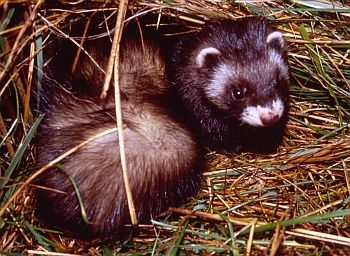
Polecat © Alexis de la Serre
The polecat is a secretive nocturnal carnivore closely related to the domestic ferret, with which it hybridises. It is dark with white facial markings and ear margins. It is a generalist feeder, eating mainly rodents and lagomorphs as well as birds and their eggs. The polecat was widespread across Britain until the 19th century, but heavy culling by game interests reduced its range to mid- Wales. Since the 1950s especially, its range has been expanding both naturally and through releasing. The polecat was listed on the NGC form in 1977, but interpretation of the returns is difficult because of possible confusion with dark feral ferrets.
The polecat benefits from partial protection under the Wildlife & Countryside Act (1981). The numbers reported nowadays to the NGC have been caught unintentionally in tunnel traps set for stoats and rats.
Further information:
Mammal Society website polecat page.
Conservation status and legislation
Status:
UK: Native. Priority species under the UK Biodiversity Action Plan
World: Least Concern (IUCN Red List)
Legislation:
Distribution and abundance
The polecat is found throughout Wales, including Anglesey. It has colonised the East Midlands, the Home Counties, the Peak District, Cumbria and Argyll. Isolated records further afield probably reflect further introduction attempts. The polecat is absent from Ireland. Animals from the Isle of Man, Shetland, the Western Isles, Mull and some parts of mainland Scotland have been confirmed as feral ferrets.
Estimates of polecat abundance (numbers of individuals in the spring) across the UK, from Birks (2008):
Recent trends from the National Gamebag Census
United Kingdom
Index of bag density from 1961 to 2009 (see statistical methods and interpretational considerations).
Error bars represent 95% confidence intervals.
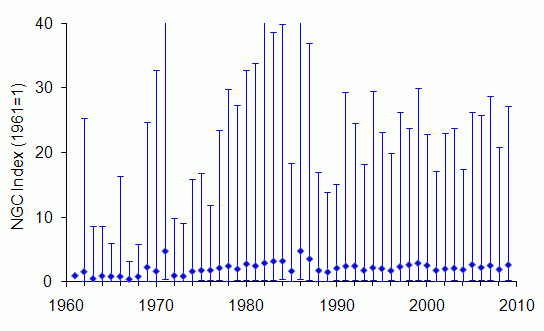
The bag index has almost tripled since 1961, but the error bars on the estimated values are so large that it is not possible to detect a significant change. The apparent increase is in line with the known range expansion and increasing abundance of this species.
Change in polecat bags over time, with 95% confidence limits (see statistical methods):
| Country |
Sites |
Start
year |
End
year |
Change (%)
1961-2009 |
Change (%)
1984-2009 |
Change (%)
1995-2009 |
| United Kingdom |
192 |
1961 |
2009 |
176
-58 to 1341 |
-14
-39 to 26 |
6
-19 to 37 |
* significant at P < 0.05
England
Index of bag density from 1976 to 2009 (see statistical methods and interpretational considerations).
Error bars represent 95% confidence intervals.
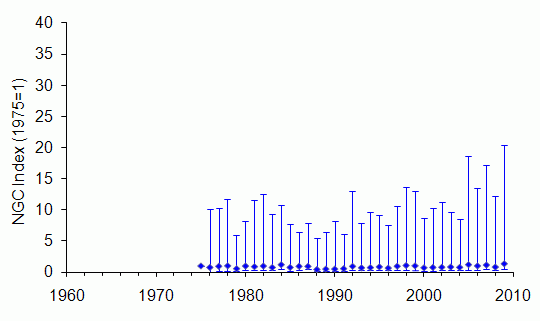
No data are available before 1976. The bag index has increased by half between 1995 and 2009, but the error bars on the estimated values are so large that it is not possilbe to detect a significant change since 1976. The apparent increase is in line with the known range expansion and increasing abundance of this species.
Change in polecat bags over time, with 95% confidence limits (see statistical methods):
| Country |
Sites |
Start
year |
End
year |
Change (%)
1961-2009 |
Change (%)
1984-2009 |
Change (%)
1995-2009 |
| England |
114 |
1976 |
2009 |
43
-47 to 776 |
36
-14 to 201 |
53*
2 to 159 |
* significant at P < 0.05
Scotland
Index of bag density from 1984 to 2009 (see statistical methods and interpretational considerations).
Error bars represent 95% confidence intervals.
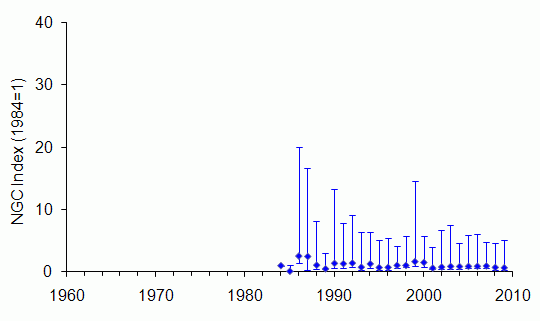
Too few data are available before 1984 for analysis. Since then, there has been no detectable change in the bag index.
Change in polecat bags over time, with 95% confidence limits (see statistical methods):
| Country |
Sites |
Start
year |
End
year |
Change (%)
1961-2009 |
Change (%)
1984-2009 |
Change (%)
1995-2009 |
| Scotland |
50 |
1984 |
2009 |
-32
-71 to 124 |
-32
-71 to 124 |
-27
-62 to 34 |
* significant at P < 0.05
Wales
Index of bag density from 1976 to 2009 (see statistical methods and interpretational considerations).
Error bars represent 95% confidence intervals.
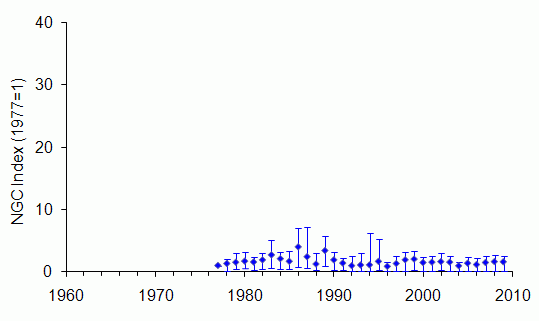
No data are available before 1976. The bag index increased until the mid-1980s then gradually declined, leading to a small but significant decline between 1984 and 2009, but no detectable change between 1976 and 2009. The trend could be the result of range expansion and increasing abundance, combined with a general decline of gamekeepering in Wales.
Change in polecat bags over time, with 95% confidence limits (see statistical methods):
| Country |
Sites |
Start
year |
End
year |
Change (%)
1961-2009 |
Change (%)
1984-2009 |
Change (%)
1995-2009 |
| Wales |
19 |
1976 |
2009 |
51
-85 to 129 |
-35*
-88 to -9 |
11
-58 to 49 |
* significant at P < 0.05
N Ireland
There are too few bag records of polecat to produce an index graph. 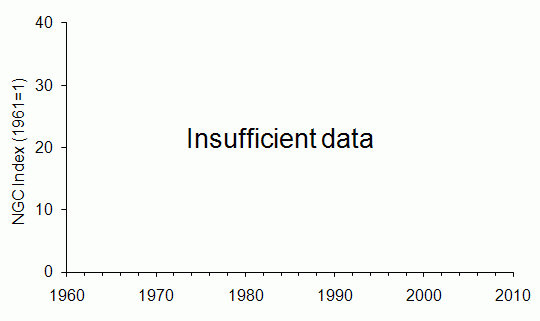
There are too few bag records of polecat to evaluate rates of change over time
| Country |
Sites |
Start
year |
End
year |
Change (%)
1961-2009 |
Change (%)
1984-2009 |
Change (%)
1995-2009 |
| N Ireland |
Too few sites |
Environmental zones
Change in polecat bags over time, with 95% confidence limits (see statistical methods):
| Environmental zone |
Sites |
Start
year |
End
year |
Change (%)
1961-2009 |
Change (%)
1984-2009 |
Change (%)
1995-2009 |
| Easterly lowlands (England/Wales) |
56 |
1976 |
2009 |
116
-38 to 1918 |
72
-8 to 372 |
15
-38 to 229 |
| Westerly lowlands (England/Wales) |
31 |
1976 |
2009 |
-32
-69 to 109 |
-39*
-64 to -10 |
-17
-50 to 18 |
| Uplands (England/Wales) |
46 |
1976 |
2009 |
150
-40 to 569 |
12
-28 to 96 |
103*
17 to 575 |
| Lowlands (Scotland) |
Too few sites |
| Intermediate uplands/islands (Scotland) |
Too few sites |
| True uplands (Scotland) |
25 |
1995 |
2009 |
no data |
no data |
-22
-83 to 113 |
* significant at P < 0.05
Comparison with BBS mammal data
No comparison with the NGC trend is possible because too few polecat records are received through the Breeding Bird Survey (BBS) organised by the British Trust for Ornithology.
Long-term trend from the National Gamebag Census
There are too few bag records of polecat to produce a trend starting before 1961.
References and further reading
- Battersby,J. (2005). UK Mammals: Species Status and Population Trends. Joint Nature Conservation Committee/Tracking Mammals Partnership, Peterborough (JNCC download page).
- Birks,J.D.S. & Kitchener,A.C. (1999). The Distribution and Status of the Polecat Mustela putorius in Britain in the 1990s. Vincent Wildlife Trust, London.
- Birks,J.D.S. (2008). The Polecat Survey of Britain 2004-2006: A Report on the Polecat's Distribution, Status and Conservation. Vincent Wildlife Trust, Ledbury.
- Harris,S. & Yalden,D.W. (2008). Mammals of the British Isles: Handbook, 4th edition. Mammal Society, Southampton.
This report should be cited as: Aebischer,N.J., Davey,P.D. & Kingdon,N.G. (2011). National Gamebag Census: Mammal Trends to 2009. Game & Wildlife Conservation Trust, Fordingbridge (http://www.gwct.org.uk/ngcmammals).
Return to species list